# basic imports
import numpy as np
import pandas as pd
import seaborn as sns
import matplotlib.pyplot as plt
from pprint import pprint
# model imports
from sklearn.neighbors import KNeighborsRegressor
from sklearn.neighbors import KNeighborsClassifier
# metric imports
from sklearn.metrics import root_mean_squared_error
from sklearn.metrics import accuracy_score
# model selection imports
from sklearn.model_selection import train_test_split
from sklearn.model_selection import KFold
from sklearn.model_selection import cross_val_score
from sklearn.model_selection import GridSearchCV
# preprocessing imports
from sklearn.preprocessing import StandardScaler
from sklearn.preprocessing import OneHotEncoder
from sklearn.impute import SimpleImputer
from sklearn.compose import ColumnTransformer
from sklearn.pipeline import Pipeline
# data imports
from palmerpenguins import load_penguinsCross-Validation
Tuning with Resampling
Objectives
In this note, we will discuss:
- the need for both validation and test sets,
- cross-validation,
- and grid search for parameter tuning.
We will conclude with an example that applies cross-validation and a grid search to the Palmer penguins data.
Python Setup
Notebook
The following Jupyter notebook contains some starter code that may be useful for following along with this note.
Validation and Test Data
Before introducing cross-validation, you might still be wondering: Why do we need both a validation set and a test set? Why not just a test set? That certainly would be easier!
- The validation set is used to select a model, through hyperparameter tuning.
- The test set is used to evaluate the model.
But again, why can’t the test set be used to select and evaluate a model? Aren’t we evaluating the model when we select it? Indeed we are, but that evaluation is only used for selection. The evaluation performed using the test data is the final evaluation of the model, which gives an estimate of how the model will perform on new, unseen data.
When we use the validation data to select a model, we are “seeing” or “looking” at that data, despite not fitting the model with that data.
Using only a test set for both selection and evaluation would lead to an optimistic estimate of the model’s performance.
The following simulations studies demonstrate the optimistic bias that results from using the test set for both selection and evaluation.
def simulate_sin_data(n, sd, seed):
np.random.seed(seed)
X = np.random.uniform(low=-2 * np.pi, high=2 * np.pi, size=(n, 1))
signal = np.sin(X).ravel()
noise = np.random.normal(loc=0, scale=sd, size=n)
y = signal + noise
return X, yk_values = np.arange(1, 20, 2)Correct Approach: Validation and Test Data
rmse_tests = []
rmse_trues = []for sim in range(250):
# simulate data
X, y = simulate_sin_data(n=500, sd=0.25, seed=sim)
# train-test split data
X_train, X_test, y_train, y_test = train_test_split(
X,
y,
test_size=0.20,
random_state=42,
)
# train-validate split the data
X_vtrain, X_validation, y_vtrain, y_validation = train_test_split(
X_train,
y_train,
test_size=0.20,
random_state=42,
)
# initalize list to store validation rmse values
rmse_val = []
for k in k_values:
knn = KNeighborsRegressor(n_neighbors=k)
knn.fit(X_vtrain, y_vtrain)
y_pred = knn.predict(X_validation)
validation_rmse = root_mean_squared_error(y_validation, y_pred)
rmse_val.append(validation_rmse)
# "select" model with best k
best_k = k_values[np.argmin(rmse_val)]
# refit model to full train data with chosen k
knn = KNeighborsRegressor(n_neighbors=best_k)
knn.fit(X_train, y_train)
# calculate and store test rmse
test_rmse = root_mean_squared_error(y_test, knn.predict(X_test))
rmse_tests.append(test_rmse)
# simulate a lot of "new" and "unseen" data
X_new, y_new = simulate_sin_data(
n=10000,
sd=0.25,
seed=42,
)
# calculate and store the "true" rmse
rmse_true = root_mean_squared_error(y_new, knn.predict(X_new))
rmse_trues.append(rmse_true)ratios = np.array(rmse_tests) / np.array(rmse_trues)
print(np.mean(ratios))
print(np.mean(ratios < 1))0.9887479393487324
0.58Show Code for Plot
fig, ax = plt.subplots()
ax.hist(ratios, bins=30, edgecolor="black")
ax.set_xlabel("RMSE Ratio: Estimated vs True")
ax.set_ylabel("Frequency")
plt.show()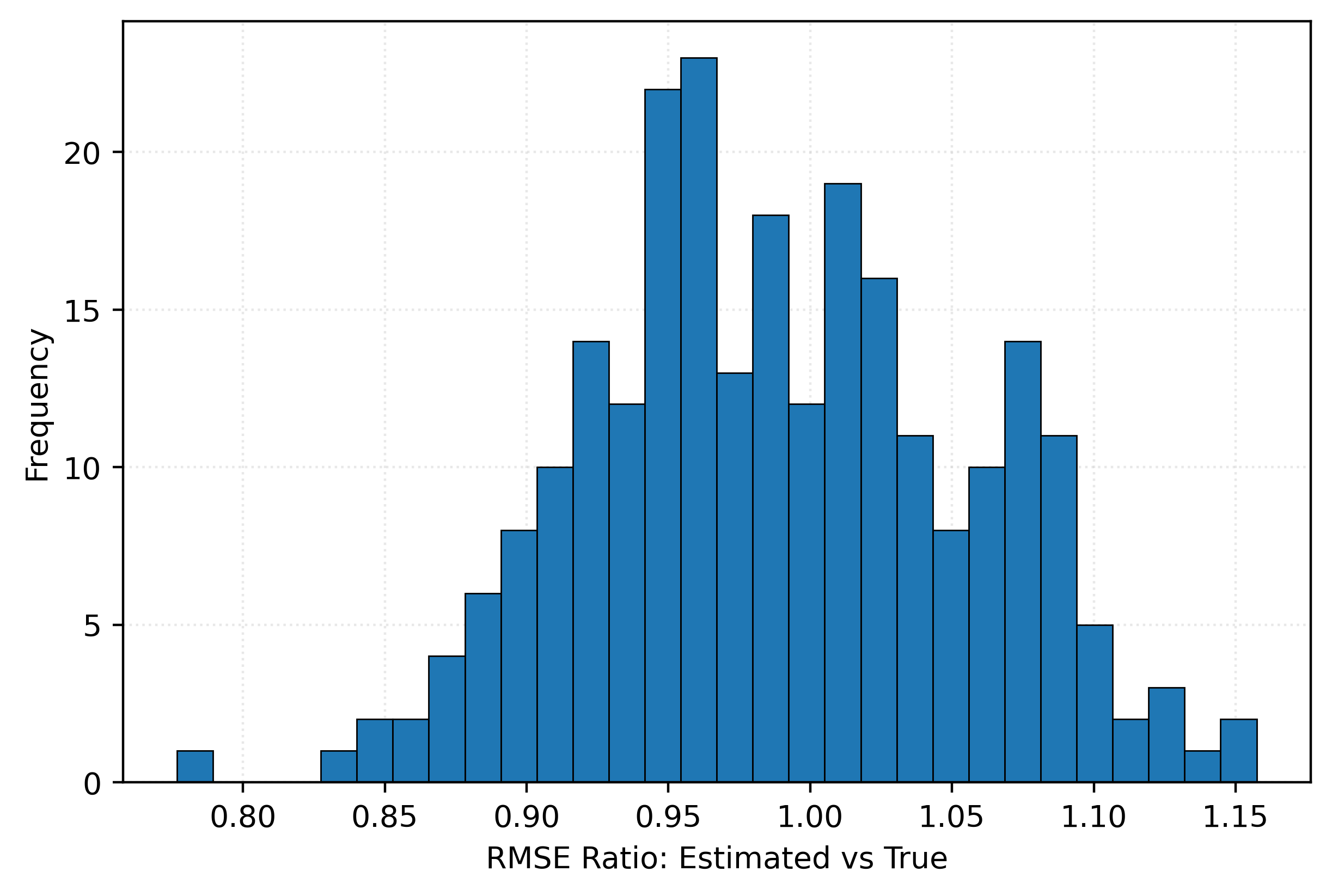
Optimistic Approach: Test Data Only
rmse_tests = []
rmse_trues = []for sim in range(250):
# simulate data
X, y = simulate_sin_data(n=500, sd=0.25, seed=sim)
# train-test split data
X_train, X_test, y_train, y_test = train_test_split(
X,
y,
test_size=0.20,
random_state=42,
)
# initalize list to store "validation" rmse values
rmse_val = []
# calculate "validation" rmse for each k
for k in k_values:
knn = KNeighborsRegressor(n_neighbors=k)
knn.fit(X_train, y_train)
y_pred = knn.predict(X_test)
validation_rmse = root_mean_squared_error(y_test, y_pred)
rmse_val.append(validation_rmse)
# "select" model with best k
best_k = k_values[np.argmin(rmse_val)]
# refit model to full train data with chosen k
knn = KNeighborsRegressor(n_neighbors=best_k)
knn.fit(X_train, y_train)
# calculate and store test rmse
test_rmse = root_mean_squared_error(y_test, knn.predict(X_test))
rmse_tests.append(test_rmse)
# simulate a lot of "new" and "unseen" data
X_new, y_new = simulate_sin_data(
n=10000,
sd=0.25,
seed=42,
)
# calculate and store the "true" rmse
rmse_true = root_mean_squared_error(y_new, knn.predict(X_new))
rmse_trues.append(rmse_true)ratios = np.array(rmse_tests) / np.array(rmse_trues)
print(np.mean(ratios))
print(np.mean(ratios < 1))0.9702873893641341
0.688Show Code for Plot
fig, ax = plt.subplots()
ax.hist(ratios, bins=30, edgecolor="black")
ax.set_xlabel("RMSE Ratio: Estimated vs True")
ax.set_ylabel("Frequency")
plt.show()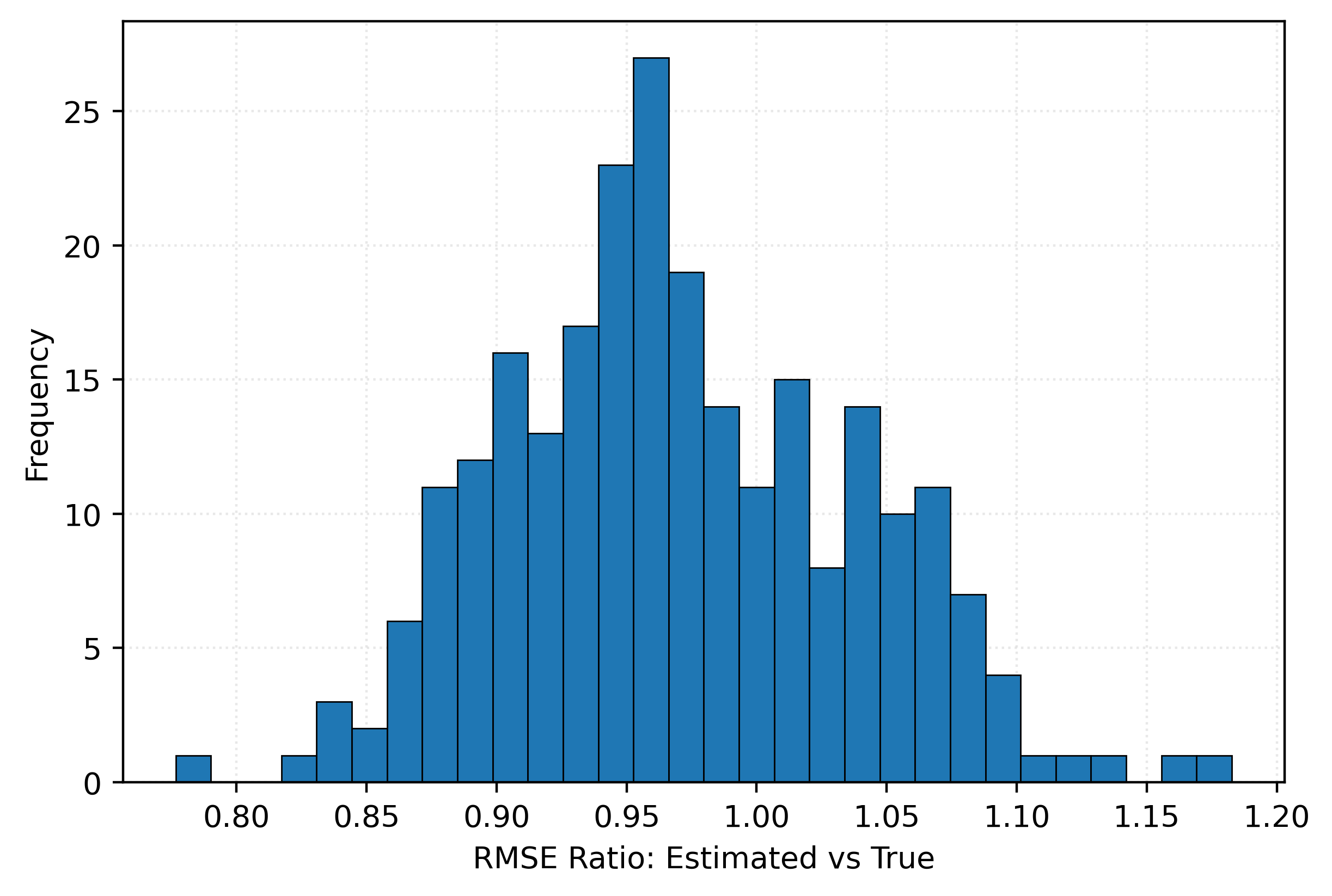
Cross-Validation
Now that we understand the need for both a validation and test set, we will further complicate the supervised learning process by introducing cross-validation. We’ll first introduce cross-validation, then explain the issue that it solves.
Let’s show an example of calculating 5-fold cross-validated RMSE for a K-Nearest Neighbors regression model with \(k=3\).
What is 5-fold cross-validation? 5-fold cross-validation is a specific case of \(k\)-fold cross-validation, where \(k=5\). Essentially, we will split the data into 5 equal parts called “folds.” Each fold will be used as a validation set while the remaining folds are used as the training set, essentially repeating our previous validation process five times. Each time through, we will calculate a metric, for example RMSE. The final cross-validated RMSE will be the average of the five RMSE values.
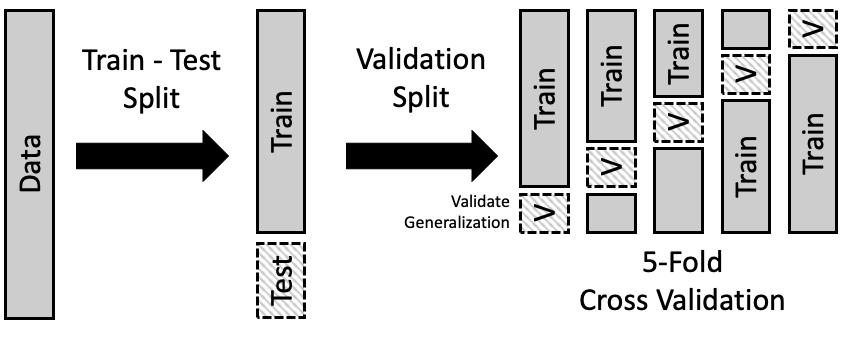
First, we’ll get some data and train-test split it. Then we’ll perform 5-fold cross-validation on the training data.
X, y = simulate_sin_data(
n=20,
sd=0.25,
seed=sim,
)X_train, X_test, y_train, y_test = train_test_split(
X,
y,
test_size=0.20,
random_state=42,
)kf = KFold(n_splits=5, shuffle=True, random_state=42)
knn = KNeighborsRegressor(n_neighbors=3)rmse_folds = []for i, (vtrain_idx, validation_idx) in enumerate(kf.split(X_train)):
print(f" Validation Set: Fold {i + 1}")
print(f" Train Indices: {vtrain_idx}")
print(f" Validation Indices: {validation_idx}")
knn.fit(X_train[vtrain_idx, :], y_train[vtrain_idx])
y_pred = knn.predict(X_train[validation_idx, :])
rmse_fold = root_mean_squared_error(y_train[validation_idx], y_pred)
print(f" Validation RMSE: {rmse_fold:.3f}")
print(f"")
rmse_folds.append(rmse_fold) Validation Set: Fold 1
Train Indices: [ 2 3 4 6 7 8 9 10 11 12 13 15]
Validation Indices: [ 0 1 5 14]
Validation RMSE: 0.708
Validation Set: Fold 2
Train Indices: [ 0 1 2 3 4 5 6 7 9 10 12 14 15]
Validation Indices: [ 8 11 13]
Validation RMSE: 0.448
Validation Set: Fold 3
Train Indices: [ 0 1 3 4 5 6 7 8 10 11 12 13 14]
Validation Indices: [ 2 9 15]
Validation RMSE: 0.403
Validation Set: Fold 4
Train Indices: [ 0 1 2 3 5 6 8 9 11 12 13 14 15]
Validation Indices: [ 4 7 10]
Validation RMSE: 0.863
Validation Set: Fold 5
Train Indices: [ 0 1 2 4 5 7 8 9 10 11 13 14 15]
Validation Indices: [ 3 6 12]
Validation RMSE: 0.249
print(f"5-Fold Cross-Validated RMSE: {np.mean(rmse_folds):.3f}")5-Fold Cross-Validated RMSE: 0.534Why would we need to do this? Doesn’t this just make things more complicated? Doesn’t this just waste a bunch of time? We’re just repeating the same thing five times!
Let’s perform another simulation study. This time we’ll compare the results of selecting a model with a single validation set versus selecting a model with 5-fold cross-validation.
# here we define the values of k we will consider
k_values = np.arange(1, 11)Tuning with Single Validation Set
# store the best k value for each simulation
k_best = []# run 100 different simulations to assess k selection stability
for seed in range(100):
# generate a new dataset for this simulation
X, y = simulate_sin_data(n=50, sd=0.25, seed=sim)
# split into training and test sets
X_train, X_test, y_train, y_test = train_test_split(
X,
y,
test_size=0.20,
random_state=seed,
)
# further split training data into train/validation for hyperparameter tuning
X_vtrain, X_validation, y_vtrain, y_validation = train_test_split(
X_train,
y_train,
test_size=0.20,
random_state=seed,
)
# store RMSE for each k value
k_rmse = []
# test each k value using validation set
for k in k_values:
knn = KNeighborsRegressor(n_neighbors=k)
knn.fit(X_vtrain, y_vtrain)
k_rmse.append(root_mean_squared_error(y_validation, knn.predict(X_validation)))
# find and store the k value with lowest validation error
k_best.append(k_values[np.argmin(k_rmse)])np.array(k_best)array([ 6, 6, 6, 2, 5, 2, 6, 2, 9, 4, 1, 2, 6, 7, 2, 3, 3,
1, 1, 3, 1, 2, 3, 3, 2, 3, 2, 1, 2, 3, 5, 2, 2, 1,
5, 4, 5, 2, 4, 2, 2, 5, 2, 10, 5, 1, 7, 3, 3, 4, 3,
2, 6, 1, 6, 1, 2, 4, 4, 1, 1, 4, 4, 6, 2, 4, 2, 4,
4, 3, 3, 3, 3, 4, 1, 3, 5, 2, 4, 2, 3, 3, 2, 6, 3,
1, 5, 4, 3, 4, 4, 3, 2, 5, 1, 1, 3, 3, 1, 3])Show Code for Plot
fig, ax = plt.subplots()
ax.bar(k_values, [k_best.count(i) for i in k_values])
ax.set_title("Repeatedly Tuning k: Single Validation Set")
ax.set_xlabel("k")
ax.set_ylabel("Times Selected")
ax.set_xticks(k_values)
plt.show()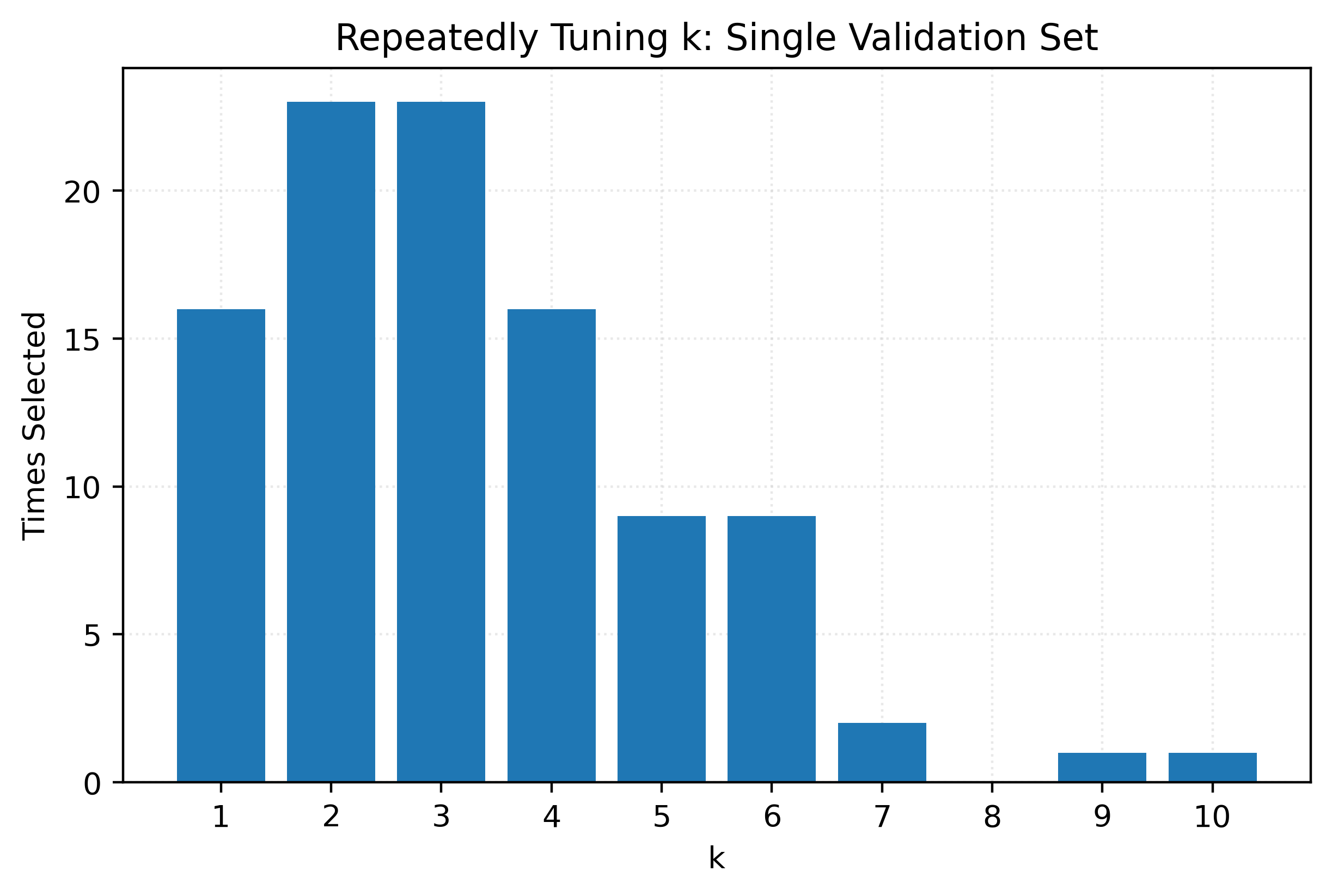
Tuning with Cross-Validation
# store the best k value for each simulation
k_best = []# run 100 different simulations to assess k selection stability
for seed in range(100):
# generate a new dataset for this simulation
X, y = simulate_sin_data(
n=50,
sd=0.25,
seed=sim,
)
# split into training and test sets
X_train, X_test, y_train, y_test = train_test_split(
X,
y,
test_size=0.20,
random_state=seed,
)
# store RMSE for each k value
k_rmse = []
# test each k value using cross-validation
for k in k_values:
knn = KNeighborsRegressor(n_neighbors=k)
# perform 5-fold cross-validation on training data
cv_scores = cross_val_score(
knn,
X_train,
y_train,
cv=5,
scoring="neg_root_mean_squared_error",
)
# convert negative RMSE back to positive and store mean
k_rmse.append(-np.mean(cv_scores))
# find and store the k value with lowest CV error
k_best.append(k_values[np.argmin(k_rmse)])np.array(k_best)array([4, 1, 4, 6, 3, 3, 5, 4, 2, 3, 4, 2, 4, 4, 4, 2, 3, 4, 2, 3, 2, 2,
2, 3, 3, 3, 4, 1, 4, 2, 4, 4, 3, 1, 4, 3, 2, 3, 4, 4, 4, 3, 5, 4,
3, 4, 4, 1, 3, 2, 3, 2, 5, 3, 4, 3, 4, 3, 4, 2, 1, 2, 3, 4, 3, 4,
3, 3, 3, 3, 3, 3, 4, 6, 2, 2, 3, 3, 3, 1, 3, 3, 3, 3, 2, 5, 2, 4,
4, 3, 4, 4, 2, 2, 1, 3, 4, 3, 1, 2])Show Code for Plot
fig, ax = plt.subplots()
ax.bar(k_values, [k_best.count(i) for i in k_values])
ax.set_title("Repeatedly Tuning k: 5-Fold Cross-Validation")
ax.set_xlabel("k")
ax.set_ylabel("Times Selected")
ax.set_xticks(k_values)
plt.show()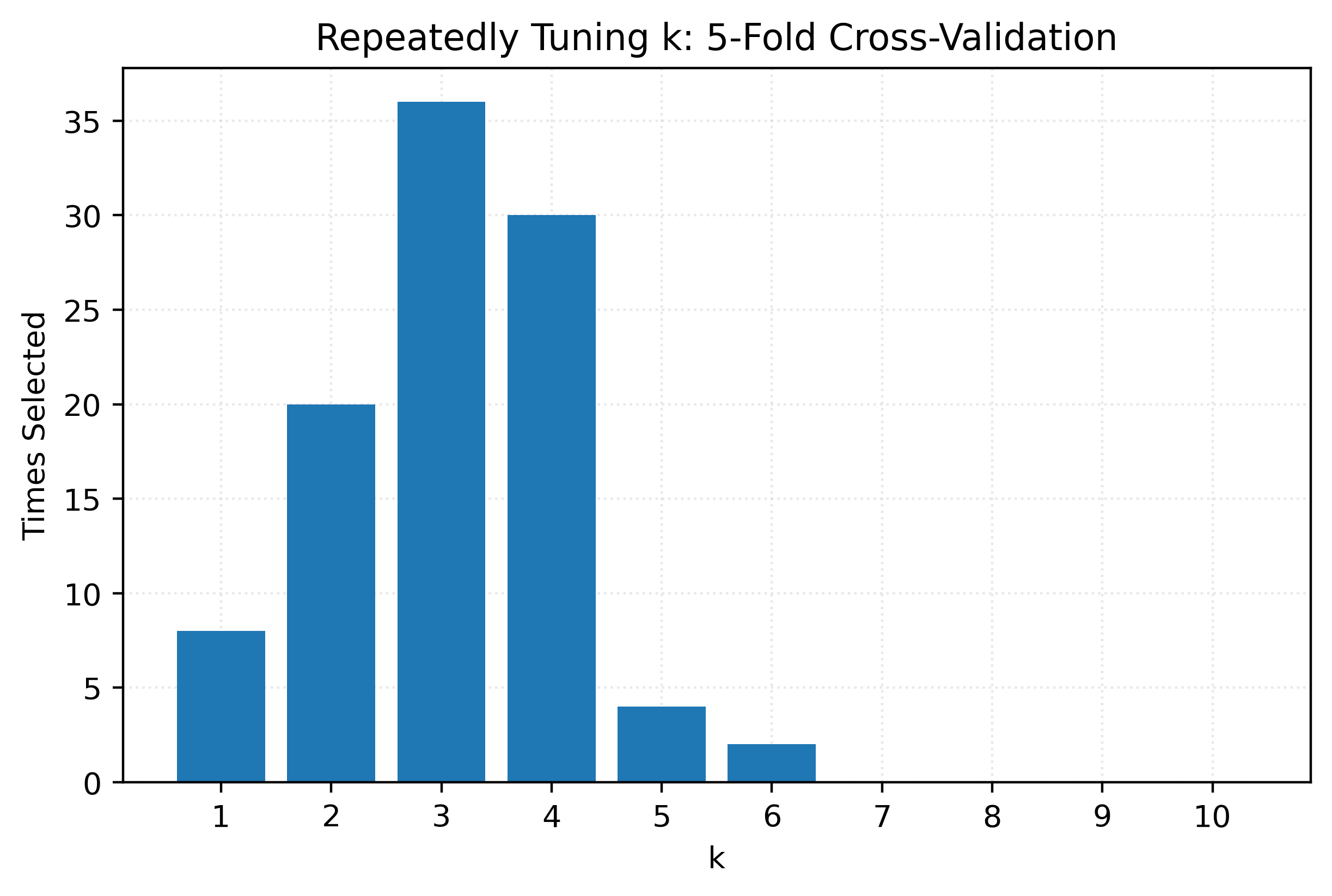
Grid Search
So far, we’ve demonstrated two things:
- The need for both validation and test data.
- The need for cross-validation.
But while we’ve shown that we need to do these things, we haven’t shown how to do them efficiently. The code we’ve written so far is not the code you would write in practice.
Instead, in practice you will want to use the GridSearchCV class, together with a Pipeline. Combining these two tools will demonstrate the true power of sklearn. At times you might need something more custom, or an alternative to GridSearchCV, but for most cases, GridSearchCV and a Pipeline will be your go-to when using sklearn to perform supervised learning.
By using GridSearchCV and a Pipeline, rather than writing for loops and other verbose code to perform parameter tuning, instead you can focus on specifying the inputs to the process. As the human in the loop, you will need to specify:
- The model(s) you want to tune.
- The hyperparameters you want to tune.
- The values you want to consider for each hyperparameter.
- The metric you want to use to evaluate the models.
- The number of folds for cross-validation.
- The preprocessing steps you want to include in the pipeline.
Let’s take a look at an example.
Example: Palmer Penguins
penguins = load_penguins()penguins_train, penguins_test = train_test_split(
penguins,
test_size=0.35,
random_state=42,
)penguins_train| species | island | bill_length_mm | bill_depth_mm | flipper_length_mm | body_mass_g | sex | year | |
|---|---|---|---|---|---|---|---|---|
| 292 | Chinstrap | Dream | 50.30 | 20.00 | 197.00 | 3,300.00 | male | 2007 |
| 302 | Chinstrap | Dream | 50.50 | 18.40 | 200.00 | 3,400.00 | female | 2008 |
| 56 | Adelie | Biscoe | 39.00 | 17.50 | 186.00 | 3,550.00 | female | 2008 |
| 271 | Gentoo | Biscoe | NaN | NaN | NaN | NaN | NaN | 2009 |
| 10 | Adelie | Torgersen | 37.80 | 17.10 | 186.00 | 3,300.00 | NaN | 2007 |
| ... | ... | ... | ... | ... | ... | ... | ... | ... |
| 188 | Gentoo | Biscoe | 42.60 | 13.70 | 213.00 | 4,950.00 | female | 2008 |
| 71 | Adelie | Torgersen | 39.70 | 18.40 | 190.00 | 3,900.00 | male | 2008 |
| 106 | Adelie | Biscoe | 38.60 | 17.20 | 199.00 | 3,750.00 | female | 2009 |
| 270 | Gentoo | Biscoe | 47.20 | 13.70 | 214.00 | 4,925.00 | female | 2009 |
| 102 | Adelie | Biscoe | 37.70 | 16.00 | 183.00 | 3,075.00 | female | 2009 |
223 rows × 8 columns
Show Code for Plot
plot = sns.jointplot(
data=penguins_train,
x="bill_length_mm",
y="bill_depth_mm",
hue="species",
edgecolor="k",
alpha=0.75,
space=0,
)
plot.set_axis_labels(
xlabel="Bill Length (mm)",
ylabel="Bill Depth (mm)",
)
plot.ax_joint.legend(
title="Species",
loc="lower left",
)
plt.show()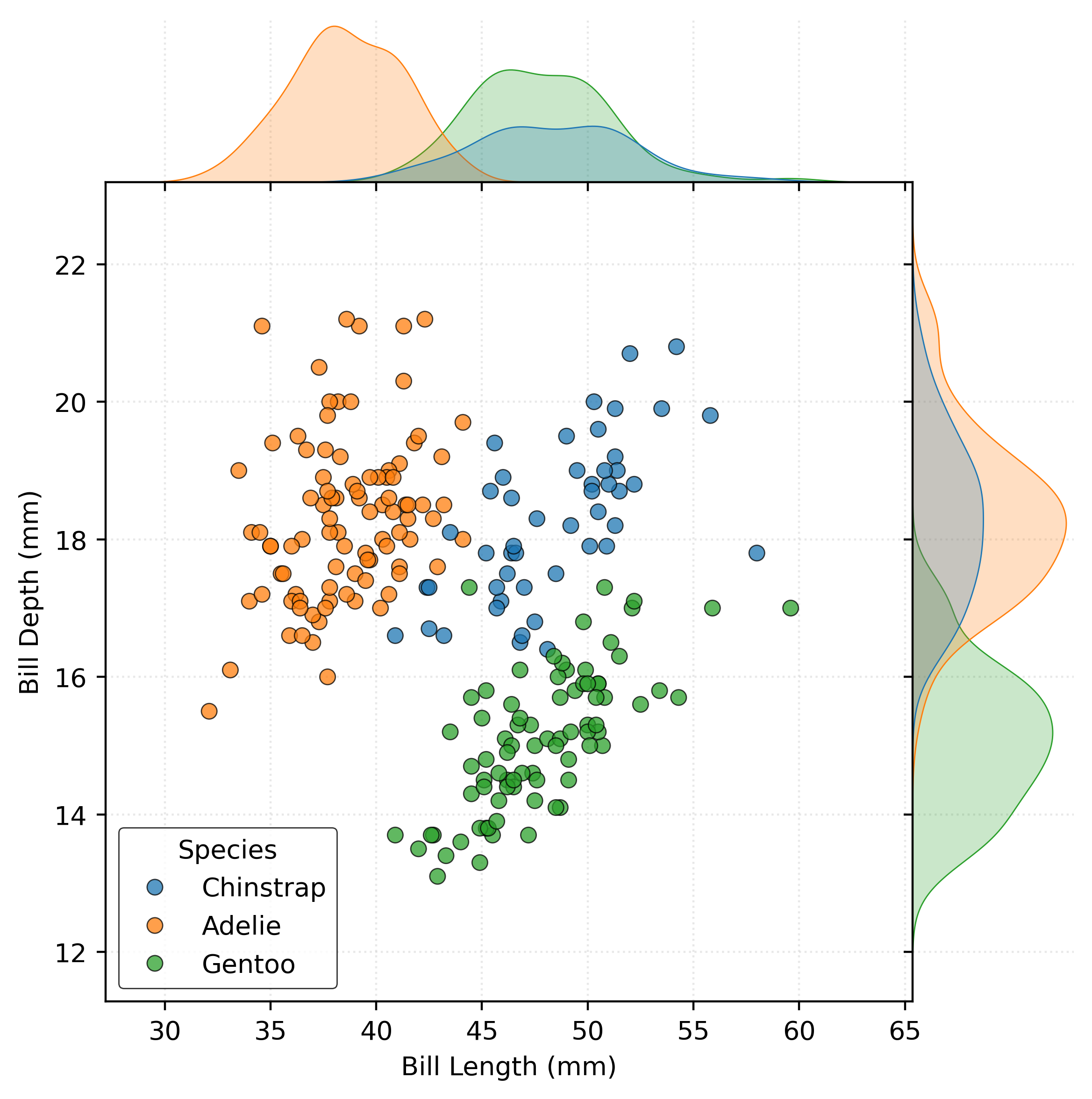
numeric_features = ["bill_length_mm", "bill_depth_mm", "body_mass_g"]
categorical_features = ["sex"]
features = numeric_features + categorical_features
target = "species"X_train = penguins_train[features]
y_train = penguins_train[target]
X_test = penguins_test[features]
y_test = penguins_test[target]# define preprocessing for numeric features
numeric_transformer = Pipeline(
[
("imputer", SimpleImputer(strategy="median")),
("scaler", StandardScaler()),
]
)
# define preprocessing for categorical features
categorical_transformer = Pipeline(
[
("imputer", SimpleImputer(strategy="most_frequent")),
("encoder", OneHotEncoder()),
]
)
# create general preprocessor
preprocessor = ColumnTransformer(
[
("numeric", numeric_transformer, numeric_features),
("categorical", categorical_transformer, categorical_features),
],
remainder="drop",
)# create pipeline with preprocessor and classifier
pipeline = Pipeline(
[
("preprocessor", preprocessor),
("classifier", KNeighborsClassifier()),
]
)# define the parameter grid
param_grid = {
"classifier__n_neighbors": [1, 5, 10, 15, 20, 25, 50],
"classifier__p": [1, 2],
"preprocessor__numeric__scaler": [None, StandardScaler()],
}# create the grid search
mod = GridSearchCV(
pipeline,
param_grid,
cv=5,
scoring="accuracy",
)modGridSearchCV(cv=5,
estimator=Pipeline(steps=[('preprocessor',
ColumnTransformer(transformers=[('numeric',
Pipeline(steps=[('imputer',
SimpleImputer(strategy='median')),
('scaler',
StandardScaler())]),
['bill_length_mm',
'bill_depth_mm',
'body_mass_g']),
('categorical',
Pipeline(steps=[('imputer',
SimpleImputer(strategy='most_frequent')),
('encoder',
OneHotEncoder())]),
['sex'])])),
('classifier', KNeighborsClassifier())]),
param_grid={'classifier__n_neighbors': [1, 5, 10, 15, 20, 25, 50],
'classifier__p': [1, 2],
'preprocessor__numeric__scaler': [None,
StandardScaler()]},
scoring='accuracy')In a Jupyter environment, please rerun this cell to show the HTML representation or trust the notebook. On GitHub, the HTML representation is unable to render, please try loading this page with nbviewer.org.
Parameters
| estimator | Pipeline(step...lassifier())]) | |
| param_grid | {'classifier__n_neighbors': [1, 5, ...], 'classifier__p': [1, 2], 'preprocessor__numeric__scaler': [None, StandardScaler()]} | |
| scoring | 'accuracy' | |
| n_jobs | None | |
| refit | True | |
| cv | 5 | |
| verbose | 0 | |
| pre_dispatch | '2*n_jobs' | |
| error_score | nan | |
| return_train_score | False |
Parameters
| transformers | [('numeric', ...), ('categorical', ...)] | |
| remainder | 'drop' | |
| sparse_threshold | 0.3 | |
| n_jobs | None | |
| transformer_weights | None | |
| verbose | False | |
| verbose_feature_names_out | True | |
| force_int_remainder_cols | 'deprecated' |
['bill_length_mm', 'bill_depth_mm', 'body_mass_g']
Parameters
| missing_values | nan | |
| strategy | 'median' | |
| fill_value | None | |
| copy | True | |
| add_indicator | False | |
| keep_empty_features | False |
Parameters
| copy | True | |
| with_mean | True | |
| with_std | True |
['sex']
Parameters
| missing_values | nan | |
| strategy | 'most_frequent' | |
| fill_value | None | |
| copy | True | |
| add_indicator | False | |
| keep_empty_features | False |
Parameters
| categories | 'auto' | |
| drop | None | |
| sparse_output | True | |
| dtype | <class 'numpy.float64'> | |
| handle_unknown | 'error' | |
| min_frequency | None | |
| max_categories | None | |
| feature_name_combiner | 'concat' |
Parameters
| n_neighbors | 5 | |
| weights | 'uniform' | |
| algorithm | 'auto' | |
| leaf_size | 30 | |
| p | 2 | |
| metric | 'minkowski' | |
| metric_params | None | |
| n_jobs | None |
# fit the model via grid search
mod.fit(X_train, y_train)GridSearchCV(cv=5,
estimator=Pipeline(steps=[('preprocessor',
ColumnTransformer(transformers=[('numeric',
Pipeline(steps=[('imputer',
SimpleImputer(strategy='median')),
('scaler',
StandardScaler())]),
['bill_length_mm',
'bill_depth_mm',
'body_mass_g']),
('categorical',
Pipeline(steps=[('imputer',
SimpleImputer(strategy='most_frequent')),
('encoder',
OneHotEncoder())]),
['sex'])])),
('classifier', KNeighborsClassifier())]),
param_grid={'classifier__n_neighbors': [1, 5, 10, 15, 20, 25, 50],
'classifier__p': [1, 2],
'preprocessor__numeric__scaler': [None,
StandardScaler()]},
scoring='accuracy')In a Jupyter environment, please rerun this cell to show the HTML representation or trust the notebook. On GitHub, the HTML representation is unable to render, please try loading this page with nbviewer.org.
Parameters
| estimator | Pipeline(step...lassifier())]) | |
| param_grid | {'classifier__n_neighbors': [1, 5, ...], 'classifier__p': [1, 2], 'preprocessor__numeric__scaler': [None, StandardScaler()]} | |
| scoring | 'accuracy' | |
| n_jobs | None | |
| refit | True | |
| cv | 5 | |
| verbose | 0 | |
| pre_dispatch | '2*n_jobs' | |
| error_score | nan | |
| return_train_score | False |
Parameters
| transformers | [('numeric', ...), ('categorical', ...)] | |
| remainder | 'drop' | |
| sparse_threshold | 0.3 | |
| n_jobs | None | |
| transformer_weights | None | |
| verbose | False | |
| verbose_feature_names_out | True | |
| force_int_remainder_cols | 'deprecated' |
['bill_length_mm', 'bill_depth_mm', 'body_mass_g']
Parameters
| missing_values | nan | |
| strategy | 'median' | |
| fill_value | None | |
| copy | True | |
| add_indicator | False | |
| keep_empty_features | False |
Parameters
| copy | True | |
| with_mean | True | |
| with_std | True |
['sex']
Parameters
| missing_values | nan | |
| strategy | 'most_frequent' | |
| fill_value | None | |
| copy | True | |
| add_indicator | False | |
| keep_empty_features | False |
Parameters
| categories | 'auto' | |
| drop | None | |
| sparse_output | True | |
| dtype | <class 'numpy.float64'> | |
| handle_unknown | 'error' | |
| min_frequency | None | |
| max_categories | None | |
| feature_name_combiner | 'concat' |
Parameters
| n_neighbors | 1 | |
| weights | 'uniform' | |
| algorithm | 'auto' | |
| leaf_size | 30 | |
| p | 1 | |
| metric | 'minkowski' | |
| metric_params | None | |
| n_jobs | None |
print(f"Best Parameters:")
pprint(mod.best_params_)Best Parameters:
{'classifier__n_neighbors': 1,
'classifier__p': 1,
'preprocessor__numeric__scaler': StandardScaler()}print(f"Best Cross-Validated Accuracy: {mod.best_score_}")Best Cross-Validated Accuracy: 0.9821212121212122# create a DataFrame to store the CV results
cv_results = pd.DataFrame(mod.cv_results_)
# select relevant columns and sort by rank
cv_results = (
cv_results[
[
"param_classifier__n_neighbors",
"param_classifier__p",
"param_preprocessor__numeric__scaler",
"mean_test_score",
"std_test_score",
]
]
.sort_values(by="mean_test_score", ascending=False)
.reset_index(drop=True)
)
# rename columns for better readability
cv_results.columns = [
"Neighbors",
"Distance Exponent",
"Scaling",
"Mean Accuracy",
"SD Accuracy",
]
# display the DataFrame
cv_results| Neighbors | Distance Exponent | Scaling | Mean Accuracy | SD Accuracy | |
|---|---|---|---|---|---|
| 0 | 1 | 1 | StandardScaler() | 0.9821 | 0.0167 |
| 1 | 10 | 2 | StandardScaler() | 0.9820 | 0.0170 |
| 2 | 5 | 1 | StandardScaler() | 0.9776 | 0.0283 |
| 3 | 1 | 2 | StandardScaler() | 0.9776 | 0.0201 |
| 4 | 5 | 2 | StandardScaler() | 0.9776 | 0.0201 |
| 5 | 15 | 2 | StandardScaler() | 0.9775 | 0.0249 |
| 6 | 25 | 2 | StandardScaler() | 0.9730 | 0.0168 |
| 7 | 20 | 2 | StandardScaler() | 0.9729 | 0.0223 |
| 8 | 15 | 1 | StandardScaler() | 0.9685 | 0.0231 |
| 9 | 10 | 1 | StandardScaler() | 0.9685 | 0.0231 |
| 10 | 20 | 1 | StandardScaler() | 0.9596 | 0.0170 |
| 11 | 25 | 1 | StandardScaler() | 0.9418 | 0.0301 |
| 12 | 50 | 2 | StandardScaler() | 0.9279 | 0.0441 |
| 13 | 1 | 2 | None | 0.8433 | 0.0415 |
| 14 | 1 | 1 | None | 0.8343 | 0.0404 |
| 15 | 50 | 1 | StandardScaler() | 0.8341 | 0.0171 |
| 16 | 5 | 1 | None | 0.7799 | 0.0406 |
| 17 | 5 | 2 | None | 0.7799 | 0.0406 |
| 18 | 15 | 1 | None | 0.7755 | 0.0396 |
| 19 | 15 | 2 | None | 0.7755 | 0.0396 |
| 20 | 10 | 2 | None | 0.7664 | 0.0661 |
| 21 | 10 | 1 | None | 0.7664 | 0.0661 |
| 22 | 25 | 2 | None | 0.7400 | 0.0163 |
| 23 | 20 | 2 | None | 0.7398 | 0.0373 |
| 24 | 25 | 1 | None | 0.7355 | 0.0160 |
| 25 | 20 | 1 | None | 0.7354 | 0.0415 |
| 26 | 50 | 1 | None | 0.7220 | 0.0171 |
| 27 | 50 | 2 | None | 0.7220 | 0.0171 |
# predict on the test data
y_test_pred = mod.predict(X_test)
# calculate and print the test accuracy
test_accuracy = accuracy_score(y_test, y_test_pred)
print(f"Test Accuracy: {test_accuracy}")Test Accuracy: 0.9834710743801653